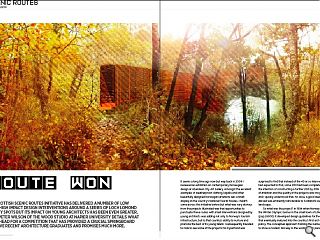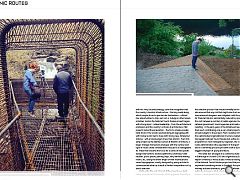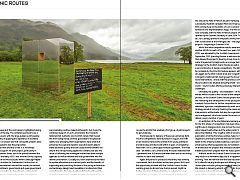Scenic Routes - Route Won
7 Aug 2014
The Scottish Scenic Routes initiative has delivered a number of low cost, high impact design interventions around a series of Loch Lomond beauty spots but its impact on young architects has been even greater. Here Peter Wilson of the wood studio at Napier University details what lies ahead for a competition that has provided a crucial springboard for five recent architecture graduates and promises much more.
So what was the project? In 1994 when Norway hosted the Winter Olympic Games in the small town of Lillehammer (pop.26000) it developed design guidelines for the event that eventually matured into the country’s first architecture policy. The conceptual approach framing the Games aimed to show a modern Norway to the world and, in parallel with this very focused strategy, came the recognition that the country’s tourism infrastructure – the long roads along which people drove to spectacular destinations – offered few opportunities to stop, eat, rest or indulge in other leisure activities. And so the National Tourist Routes project began, with strong input – indeed leadership - from the architectural profession and the country’s schools of architecture. Pilot projects tested the proposition – the first a simple wooden toilet block in the woods reached along an aggregate path with marker posts tied to trees with strong rope. Simple but striking – with a total budget of less than £5000. From this early project by the talented Jensen & Skodvin Architects, a larger strategic framework emerged, with the number and type of routes under consideration reduced to a manageable 18. These then became the focus for a series of site-specific design interventions (lookout platforms, bird hides, toilet facilities, picnic places, parking stops, ferry terminal waiting rooms, etc.) along the entire length of their individual and varied topographies, mostly designed by young architects commissioned either as a result of limited competitions or by direct selection.
Pertinently, the cost of most of the projects was kept below procurement thresholds, allowing greater flexibility in the selection process than would normally be the case. This also ensured that any risk that might arise from engaging inexperienced designers was mitigated, with the potential for financial risk also substantially reduced by spreading the cost between a number of public agencies (local and national government, tourist agencies and roads authorities) resulting - in the early years of the initiative at least - in them each contributing only a very small proportion of their annual budgets to the project. Much could be written about the sophisticated organizational structure created for the Norwegian National Tourist Routes but suffice to say the programme is now managed by Vegvesen, the country’s roads administration (the equivalent of Transport Scotland) and it is extremely proud to proclaim itself as Europe’s biggest employer of young architects.
This latter fact emerged at a conference held at the Hub in Edinburgh in October 2010 and organised by Edinburgh Napier University’s Wood Studio. Aimed at raising awareness of the National Tourist Routes project and the potential to implement something similar in Scotland, the speakers from Norway included architects, government officials and roads authority managers, all of whom had been involved in the project’s development and, in the case of the architects, directly in several of the commissions highlighted during the course of the day. The conference proved to be a compelling event, with the large audience enthused by the possibility of applying the experience in Scotland. The overall conclusion was that some pilot projects were urgently needed to test the proposition.
That was then and this is now. It is not always easy to find support for pilot project, particularly in difficult economic times, but in the period between the conference and early 2013, I was involved (in my capacity as director of the Wood Studio within Edinburgh Napier University’s Institute for Sustainable Construction) in countless presentations around the country to national and local politicians, government and quasi government agencies, local authority departments, professional organisations and community groups. The response was invariably positive, indeed enthusiastic, but it was the combined support of Loch Lomond and the Trossachs National Park Authority and Scottish Canals that moved this from being merely another good idea to the physical reality now emerging. Both organisations have small but extremely focused and dynamic executive teams able to make decisions quickly and both could see the benefits not only of the concept being applied to Scotland, but also the virtue of following the Norwegian model that drew multiple agencies as well as national and local government into the delivery mechanism. Crucially too, both understood the need to explore alternative procurement paths and the benefits of supporting and promoting the best of the young architecture and landscape design talent available in Scotland and their commitment to this helped enthuse Richard Lochhead, the Scottish Government’s Cabinet Secretary for Rural Affairs, to secure the £500k that enabled a first group of pilot projects to get underway.
The timescale for delivery of these was extremely tight. The first competitions were launched in August 2013 with a two-week turnaround for entries from young architects and landscape architects still within 5 years of completing RIBA Part II or its Landscape Institute equivalent. The three sites - all within Loch Lomond & the Trossachs National Park - generated over 100 entries between them and a five-strong shortlist for each was selected.
Again, the period to produce a final entry was severely constrained. Each shortlisted entrant was given £1000 and the opportunity to meet with the Scottish Scenic Routes working group to discuss how their proposals might be further developed. Final judging by an external jury was completed by October 2013 and the winning designs for the sites at the Falls of Falloch (by john Kennedy), Loch Lubnaig (by Ruairidh Campbell Moir) and Inveruglas (by BTE Architecture) on the banks of Loch Lomond moved forward to the implementation stage. The first results are now complete, with the Falls of Falloch project officially opened by the Cabinet Secretary in June 2014. The project at Loch Lubnaig opened to the public shortly thereafter, with construction at the Inveruglas site – the largest of the projects - beginning in Summer 2014.
Whilst the initial competition results were emerging, another £500k for each of the next two years (2014 and 2015) was allocated by the Scottish Government in its September 2013 Spending Review, a welcome development that allowed the project’s Steering Group (now involving some 10 agencies) to begin work on a longer term National Strategy for the Scottish Scenic Routes as well as promoting a second tranche of design competitions. The latter will be complete by the time this feature appears, with sites at Laggan (on Scottish Canals land) and Corgarth in the Cairngorms National Park having been the focus for two more interventions. And as with the previous competitions, these locations are situated along important – and extremely scenic – tourist routes offering extremely interesting design challenges.
Ultimately the quality – and realisation – of the winning entries will be crucial to the success of the competition process, to the Scottish Scenic Routes project itself and to the mentoring and development of the young designers involved. Future sites for further competitions are being identified, a process complemented by work on the National Strategy aimed at not only finalising the routes along which interventions will be made, but also the organizational and management structures needed to ensure consistent delivery over a number of years.
An exhibition of the shortlisted and winning entries for the first phase of competitions has been shown at the Lighthouse in Glasgow and is due to tour the country to allow relevant authorities and the wider public to learn more about the initiative. This, together with an accompanying publication of all the first phase entries, helps to fulfill the organisers’ promise to promote the best of Scotland’s young talent to the widest possible audience, a process further enhanced by offering separate sites to Scotland’s schools of architecture for projects that introduce students to the initiative and which prepare them for future participation in it.
Without doubt the Scottish Scenic Routes initiative is still very much in its formative days, but it is happening and it is evolving. Time will tell how well the idea has been translated to Scotland’s varying landscape and differing tourist routes (future plans include cycling and walking trails), but for now the project is delivering what it set out to do: to provide experience and practice to a previously undernourished group within Scotland’s design professions.
|
|
Read next: Commonwealth Games - Starting Blocks
Read previous: Rural Mural - Colouring Opinion
Back to August 2014
Browse Features Archive
Search
News
For more news from the industry visit our News section.
Features & Reports
For more information from the industry visit our Features & Reports section.





